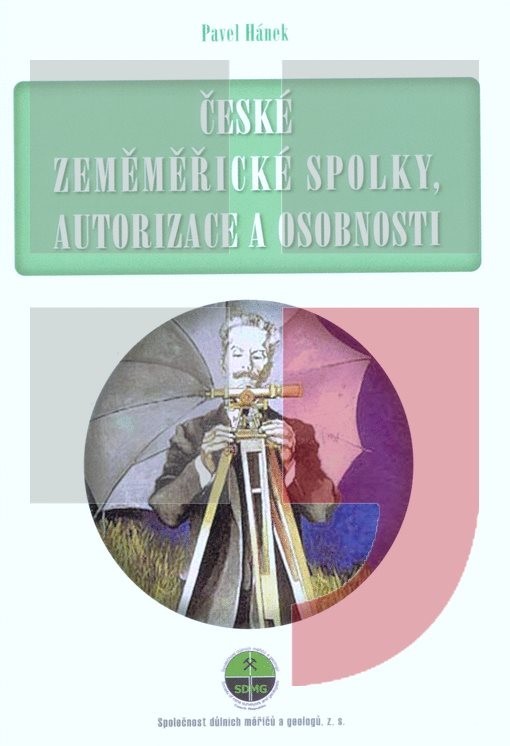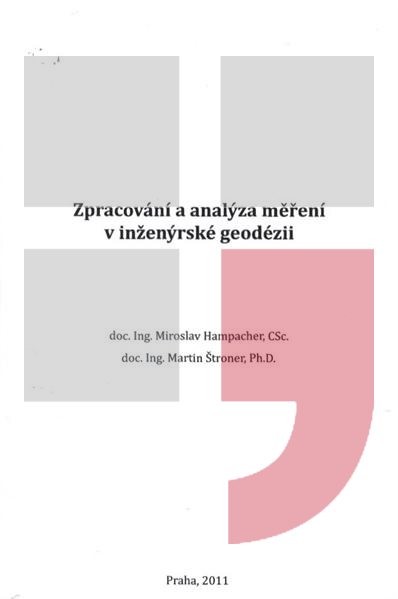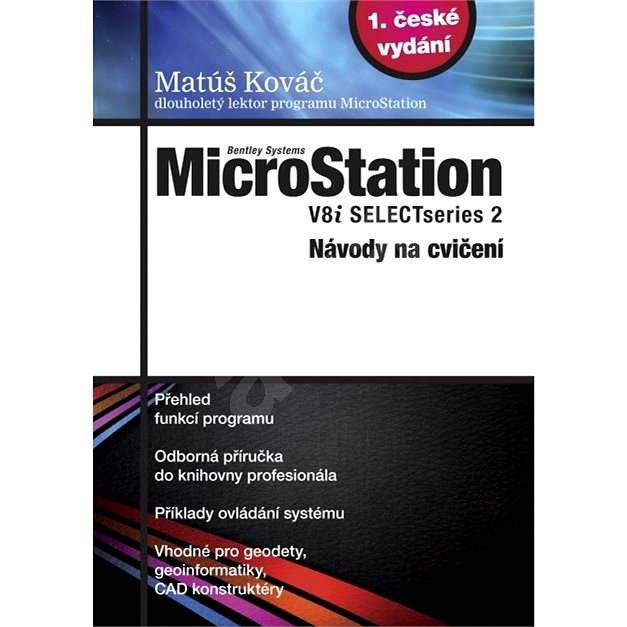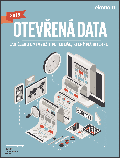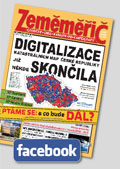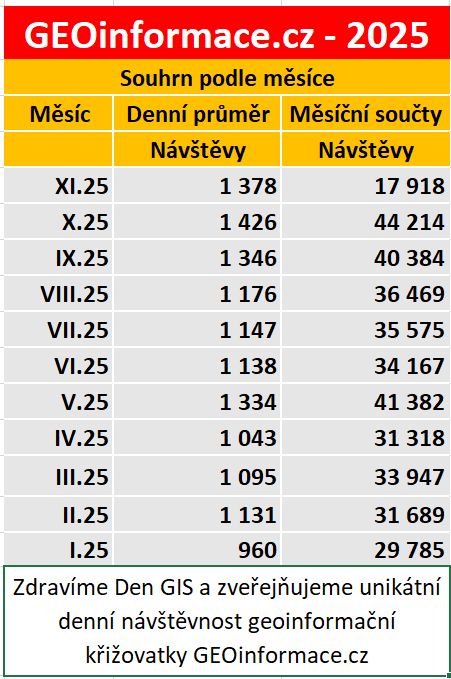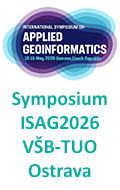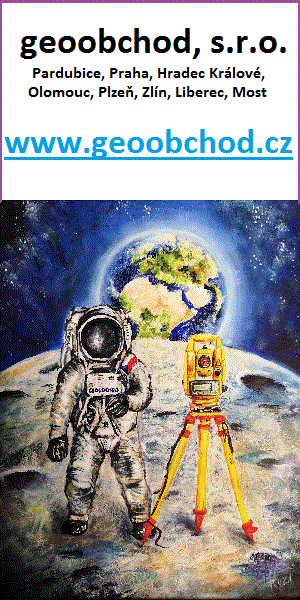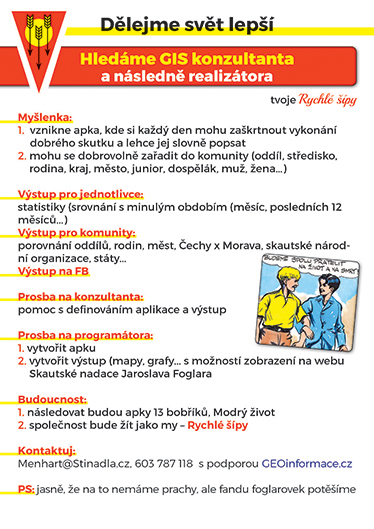zprávy
zdroje zpráv:Ohlédnutí za letošní Geomatikou v projektech
11.10.2018 0:02 Blogující geomatici - FAV ZČU Minulý týden proběhl další ročník Geomatiky v projektech, letos opět jako společná akce tří konferencí pod hlavičkou "Spojená konference ISAF & Geomatika v projektech a Plan4All". Oproti předchozím ročníkům se letos poprvé konala konference v prostorách centra NTIS, což, jak doufáme, bude pro další ročníky znamenat rostoucí návštěvnost. První den konference věnovaný výsledkům projektů především v precizním zemědělství přilákal 60 účastníků. Druhý den spojený s workshopem projektu Peregrinus Silva Bohemica a věnující se ochraně kulturního dědictví, dopravě a praktickému využití geotechnologií navštívilo 30 účastníků. Doufáme, že témata a program konference splnil očekávání účastníků a zanechal dobrý dojem. Profesionální reportáž si můžete přečíst přímo na info portále ZČU. Budeme se těšit na setkání při příštím ročníku zase za rok!Státní pozemkový úřad předává zkušenosti slovenským kolegům
11.10.2018 0:00 Státní pozemkový úřad Praha, 11. říjen 2018 – Delegace Státního pozemkového úřadu v čele se zástupcem ústředního ředitele Martinem Vrbou se účastní mezinárodní vědecké konference „Slovensko — krajina neznámych vlastníkov“, která se koná 11. a 12. října 2018 ve slovenské Nitře.Fotogalerie: 21. setkání zákazníků firmy T-Mapy
10.10.2018 23:41 GeoBusiness Jednadvacáté každoroční setkání společnosti T-MAPY se konalo počátkem října. V předchozím článku jsme vás seznámili s novinkami, které byly na akci představeny. Podívejte se ... PřečístCORSICA: Satellite Images Highlight Major Oil Spill
10.10.2018 20:11 GISCafe.com Webcasts-Webinars
French and Italian maritime authorities have commenced cleaning a major spill that has spread 20 kilometers in the …
Garmin® G5000 integrated flight deck upgrade makes significant progress towards certification in the Citation Excel/XLS
10.10.2018 20:09 GISCafe.com Webcasts-Webinars OLATHE, Kan. — (BUSINESS WIRE) — October 10, 2018 — Garmin International, Inc., a unit of Garmin Ltd. (NASDAQ: GRMN), today …Cape Furthers Mission to Power the Aerial Enterprise with Announcement of Major Platform Updates to Enhance Drone Telepresence
10.10.2018 20:09 GISCafe.com Webcasts-Webinars Updates to Cape Aerial Telepresence platform and Cape Cloud include industry-first capabilities to improve real-time aerial visibilityREDWOOD CITY, …
Garmin® announces availability of the G700 TXi flight display
10.10.2018 20:08 GISCafe.com Webcasts-Webinars Retrofit solutions target popular Cessna Citation business jetsOLATHE, Kan. — (BUSINESS WIRE) — October 10, 2018 — Garmin …
Maxar Technologies' DigitalGlobe and Ecopia Tech Corporation produce first high-precision U.S. building footprints dataset created with machine learning
10.10.2018 20:07 GISCafe.com Webcasts-Webinars WESTMINSTER, CO, Oct. 10, 2018 — (PRNewswire) — DigitalGlobe, a Maxar Technologies company (NYSE: MAXR) (TSX: MAXR), today …XRY Drone - new technology to acquire and analyze drone data - is introduced by MSAB and URSA
10.10.2018 20:06 GISCafe.com Webcasts-Webinars ARLINGTON, Va., Oct. 10, 2018 — (PRNewswire) — XRY Drone lets investigators extract and analyze data from popular drone models being …New Road-SIT Survey v.7.0 at INTERGEO 2018 !!
10.10.2018 20:06 GISCafe.com Webcasts-Webinars INTERGEO represents today the Global Hub Fair of the Geospatial Community, the leading international trade fair for geodesy, geoinformation and …Aerial Drones and UAV in Industry and Defense Research Bundle: Supporting Technologies, Solutions, Market Outlook and Forecasts 2018 - 2025 - ResearchAndMarkets.com
10.10.2018 20:05 GISCafe.com Webcasts-Webinars DUBLIN — (BUSINESS WIRE) — October 10, 2018 — The "Aerial Drones and UAV in Industry and Defense: Supporting Technologies, …Alteryx Recognizes the Next Class of Analytics Excellence Award Winners and ACEs at Inspire Europe
10.10.2018 20:05 GISCafe.com Webcasts-Webinars Honorees Leverage Alteryx to Alter Careers, Alter Culture and Alter CommunitiesLONDON, Oct. 10, 2018 — (PRNewswire) — Alteryx, …
Solv3D Releases Support for Additional Datasets within SiteVisit360™ Geospatial Collaboration Platform
10.10.2018 20:04 GISCafe.com Webcasts-Webinars CALGARY – October 10, 2018 - Solv3D, a leading provider of point cloud processing, geospatial data visualization and collaboration tools …Zahájen vývoj lunárního motoru
10.10.2018 17:12 Český Kosmický PortálAmbiciózní plány ESA v následující dekádě kosmického průzkumu nás povedou za Mezinárodní kosmickou stanici k Měsíci a Marsu a slibují mnoho vědeckých objevů, z nichž budou těžit všichni lidé na Zemi. V rámci podpory těchto chystaných aktivit zahajuje ESA vývoj výkonného motoru určeného právě pro kosmický průzkum.
Odstávka Modulu Zakázka DTM PK
10.10.2018 14:00 Plzeňský kraj V souvislosti s upgrade datového skladu ÚMPS DTM PK bude provedena odstávka Modulu Zakázka DTM PK, která proběhne od čtvrtka 11. 10. 2018 cca od 6 hod do úterý 16. 10. 2018 cca 20 hod. Obnovení provozu Modulu Zakázka DTM PK proběhne nejpozději ve středu 17. 10. 2018. V průběhu odstávky nebudou dostupné služby a aplikace Modulu Zakázka DTM PK. Více..Letecké snímky 2017
10.10.2018 13:50 Plzeňský kraj Do všech relevantních mapových služeb byla doplněna ortofotomapa pořízená leteckým měřickým snímkováním v období květen-srpen roku 2017. Jedná se o data z produkce Českého úřadu zeměměřického a katastrálního. Data jsou dostupná například v mapové službě Letecké snímky 2017, 2015, 2013, 2011, 2008, 2005, 2002, 1998, 1947-62, která umožňuje zobrazení ortofotomap pořízených v různých letech včetně zobrazení přesných datumů snímkování.Oil spill spread
10.10.2018 12:22 ESA Observing the Earth
The Copernicus Sentinel-1 mission returns images showing how oil is spreading in the Mediterranean Sea following a collision between two ships
Hexagon presents solutions for smart digital realities at INTERGEO 2018
10.10.2018 12:21 GISCafe.com Webcasts-Webinars Stockholm, Sweden, 9 October 2018 -- Hexagon AB, a global leader in digital solutions, is showcasing its extensive portfolio of reality capture …Tiskové prohlášení: Lucembursko a Česká republika spolupracují v rámci průzkumu a využívání zdrojů z vesmíru
10.10.2018 11:30 Český Kosmický PortálLucemburk a Praha, 10. října 2018 - Vláda Lucemburského velkovévodství zastoupená místopředsedou vlády a ministrem hospodářství Étiennem Schneiderem a Česká republika zastoupená ministrem dopravy Danem Ťokem podepsali Memorandum o porozumění o spolupráci v rámci průzkumu a využívání zdrojů z vesmíru.
České předsednictví v Auditní komisi Evropské kosmické agentury úspěšně končí. Prezident NKÚ přijal české zástupce
10.10.2018 11:03 Český Kosmický PortálPrezident NKÚ Miloslav Kala spolu s vrchním ředitelem kontrolní sekce Stanislavem Kouckým přijali 2. října české zástupce působící v Auditní komisi Evropské kosmické agentury (ESA) Luboše Rokose a Reginu Charyparovou. Projednali spolu úspěšný průběh českého předsednictví a jeho završení na zasedání Administrativní a finanční komise ESA, jež proběhlo v září 2018 v Paříži.
GSA Open Days builds on momentum of World Space Week
10.10.2018 10:56 European GNSS Agency
World Space Week, an international celebration of the contribution of science and technology to the betterment of the human condition, ends today, October 10. However, some of the associated events extend well beyond the week. One such event is the GSA Open Days, to be held on 16-17 November, during Czech Space Week.
Since the United Nations General Assembly declared World Space Week in 1999, it has grown into the largest public space-related event on Earth, with more than 4,000 events in 82 countries celebrating the benefits of space in 2017.
The theme of this year’s World Space Week is “Space Unites the World” and the Week is packed with space education and outreach events held by space agencies, aerospace companies, schools, planetaria, museums, and astronomy clubs around the world. Once such event is the European GNSS Agency’s (GSA) Open Days, which is being organized this year as part of the activities of Czech Space Week 2018, on November 12-16.
Read this: 2018 GSA Open Days. Mark your calendar
On Friday 16 and Saturday 17 November, the GSA will throw open the doors of its Prague headquarters to the public for the fourth year in a row, offering a unique opportunity to get an insider’s look at the European GNSS (Global Navigation Satellite System) services and the people behind them.
GSA Open Days 2018: From Launch to Services
The GSA Open Days will give you a chance to experience the journey of Galileo satellites from the rocket launch in Kourou, French Guiana, to the services used by citizens and business worldwide. This is your opportunity to learn more about what the European Union is doing in space, the crucial role of the GSA, and the impact of satellite navigation on our daily lives.
The programme includes exciting seminars and space workshops, competitions and quizzes, programmes for school visits, and other fun educational activities. Come visit us to see and follow Galileo satellites, take a selfie in space, try landing a plane with EGNOS or experience a Search and Rescue with the help of Galileo. There will also be opportunities to win great prizes!
If you would like to visit the GSA Open Days as a school, please fill in this registration form. A draft programme of the event can be found here.
Media note: This feature can be republished without charge provided the European GNSS Agency (GSA) is acknowledged as the source at the top or the bottom of the story. You must request permission before you use any of the photographs on the site. If you republish, we would be grateful if you could link back to the GSA website (http://www.gsa.europa.eu).
Odborný referent/vrchní referent v oddělení právním č. 2 na Katastrálním pracovišti Brno-město
10.10.2018 9:50 ČÚZK - volná místa Katastrální úřad pro Jihomoravský kraj - Katastrální pracoviště Brno-město vypisuje výběrové řízení na místo Odborný referent/vrchní referent v oddělení právním č. 2 na Katastrálním pracovišti Brno-městoOdborný referent/vrchní referent v oddělení právním č. 2 na Katastrálním pracovišti Brno-město
10.10.2018 9:50 ČÚZK /Urady/Katastralni-urady/Katastralni-urady/Katastralni-urad-pro-Jihomoravsky-kraj/Uredni-deska/Oznameni-a-jina-uredni-sdeleni/Volna-mista/Odborny-referent-vrchni-referent-v-oddeleni-pravniOdborný referent/vrchní referent v oddělení právním č. 2 na Katastrálním pracovišti Brno-město
10.10.2018 9:50 ČÚZK - předpisy a opatření Katastrální úřad pro Jihomoravský kraj - Katastrální pracoviště Brno-městovypisuje výběrové řízení na místo
Odborný referent/vrchní referent v oddělení právním č. 2 na Katastrálním pracovišti Brno-město
Odborný referent/vrchní referent v oddělení dokumentace KN na Katastrálním pracovišti Břeclav
10.10.2018 9:46 ČÚZK /Urady/Katastralni-urady/Katastralni-urady/Katastralni-urad-pro-Jihomoravsky-kraj/Uredni-deska/Oznameni-a-jina-uredni-sdeleni/Volna-mista/Odborny-referent-vrchni-referent-v-oddeleni-do-(1)Odborný referent/vrchní referent v oddělení dokumentace KN na Katastrálním pracovišti Břeclav
10.10.2018 9:46 ČÚZK - volná místa Katastrální úřad pro Jihomoravský kraj - Katastrální pracoviště Břeclav vypisuje výběrové řízení na místo Odborný referent/vrchní referent v oddělení dokumentace KN na Katastrálním pracovišti BřeclavOdborný referent/vrchní referent v oddělení dokumentace KN na Katastrálním pracovišti Břeclav
10.10.2018 9:46 ČÚZK - předpisy a opatření Katastrální úřad pro Jihomoravský kraj - Katastrální pracoviště Břeclavvypisuje výběrové řízení na místo
Odborný referent/vrchní referent v oddělení dokumentace KN na Katastrálním pracovišti Břeclav
Esri Collaborates with Alibaba Cloud, Greatly Extending Location Intelligence (ArcNews Online)
10.10.2018 9:00 GISCafe.com Webcasts-Webinars20181010 Vrchní referent/rada oddělení aktualizace katastru nemovitostí
10.10.2018 8:46 ČÚZK /Urady/Katastralni-urady/Katastralni-urady/Katastralni-urad-pro-Stredocesky-kraj/Katastralni-pracoviste/KP-Mlada-Boleslav/O-uradu/Aktuality/20161013Rada-odborny-rada-–-informatik-(2)20181010 Vrchní referent/rada oddělení aktualizace katastru nemovitostí
10.10.2018 8:46 ČÚZK - předpisy a opatření Katastrální úřad pro Středočeský kraj - Katastrální pracoviště Mladá Boleslav Vyhlášení výběrového řízení: Vrchní referent/rada oddělení aktualizace katastru nemovitostí V části "Úřední deska", v sekci "Oznámení a jiná úřední sdělení" bylo vystaveno "Oznámení o vyhlášení výběrového řízení na obsazení služebního místa Vrchní referent/rada oddělení aktualizace katastru nemovitostí"Vrchní referent/rada oddělení aktualizace katastru nemovitostí
10.10.2018 8:45 ČÚZK - předpisy a opatření Katastrální úřad pro Středočeský kraj - Katastrální pracoviště Mladá Boleslavvypisuje výběrové řízení na místo Vrchní referent/rada oddělení aktualizace katastru nemovitostí
Vrchní referent/rada oddělení aktualizace katastru nemovitostí
Vrchní referent/rada oddělení aktualizace katastru nemovitostí
10.10.2018 8:45 ČÚZK - volná místa Katastrální úřad pro Středočeský kraj - Katastrální pracoviště Mladá Boleslav vypisuje výběrové řízení na místo Vrchní referent/rada oddělení aktualizace katastru nemovitostíVrchní referent/rada oddělení aktualizace katastru nemovitostí
10.10.2018 8:45 ČÚZK /Urady/Katastralni-urady/Katastralni-urady/Katastralni-urad-pro-Stredocesky-kraj/Uredni-deska/Oznameni-a-jina-uredni-sdeleni/Volna-mista/Vrchni-referent-rada-oddeleni-aktualizace-katastruKartografická výročí (pozvánka)
10.10.2018 8:14 GISportal.cz
Česká kartografická společnost zve na akci Kartografická výročí s osmičkou na konci, která se uskuteční 20. listopadu od 13:00 v Praze na Rooseveltově 23.
The post Kartografická výročí (pozvánka) appeared first on GISportal.cz.
Firma T-MAPY na letošním setkání uživatelů představila více novinek než obvykle
10.10.2018 7:49 GeoBusiness Na začátku října se konalo každoroční setkání uživatelů společnosti T-MAPY, tentokrát v pořadí již jednadvacáté. Po dvou letech se akce vrátila zpět na Seč ... PřečístFunded PhD positions at Temple University
10.10.2018 7:24 Funded PhD positions at Temple University Department of Geography and Urban Studies The Department of Geography and Urban Studies at Temple University in Philadelphia, Pennsylvania is accepting applications for the possibility of two funded doctoral position beginning January 2019. Applications will be considered on a rolling basis until December 7, 2018. The doctoral program focuses […]Tenure-track faculty position in GIScience (assistant professor)
10.10.2018 7:23 The Department of Geography at The Pennsylvania State University, University Park invites applications for a tenure-track faculty position at the rank of Assistant Professor specializing in geographic information science (GIScience). We are interested in candidates who will strengthen the department’s research and teaching program and help build strong connections to other relevant science communities. Candidates […]Konzultační hodiny ZS 2018 [Katedra aplikované geoinformatiky a kartografie, byTopic]
10.10.2018 6:40 Katedra aplikované geoinformatiky a kartografie Přf UK Konzultační hodiny zaměstnanců katedry aplikované geoinformatiky a kartografie v zimním semestru 2018.INSPIRE téma Rozšířené Parcely (CPX)
10.10.2018 2:00 Cenia - Katalog metadat ČR - INSPIRE Rozšíření má za cíl poskytovat katastrální mapu s obsahem podle vyhlášky ve vektorové podobě ve struktuře plně v souladu se strukturou danou směrnicí INSPIRE. Data rozšiřují směrnici INSPIRE pro téma katastrální parcely (CP) o věcná břemena, geodetické body, další prvky mapy, původní obloukovou geometrii a o parcely určené definičním bodem (ty pouze v oblastech s analogovou mapou). Vychází z katastrální mapy, která je závazným státním mapovým dílem velkého měřítka, obsahuje body polohového bodového pole, polohopis a popis a může mít formu digitální mapy, analogové mapy nebo digitalizované mapy. Publikovaná data obsahují katastrální území pro celou Českou Republiku, parcely a jejich hranice, věcná břemena, další prvky mapy a původní obloukovou geometrii z území, kde je digitální mapa (k 26. 11. 2018 je to 96,16% území České republiky, t.j. 75 840,00km2) a ve zbytku území katastrální parcely určené pouze definičním bodem (tedy bez hranic a polygonu). Katastrální parcely a hranice obsahují oproti datové sadě INSPIRE některé atributy navíc. Jedná se o typ hranice, způsob využití území, druh pozemku, vazbu na budovu a o mapové značky. Více katastrální zákon 344/1992 SB., katastrální vyhláška č.26/2007 Sb. v platném znění a INSPIRE Data Specification on Cadastral Parcels v 3.0.1. Data ve formátu GML 3.2.1 jsou validní proti schématu XML pro Rozšířené Parcely (CPX) ve verzi 4.0.Norsko v čele výzkumu hybridního pohonu
9.10.2018 21:10 Český Kosmický PortálVe čtvrtek 27. září dosáhla první norská hybridní raketa vesmíru, čímž demonstrovala možnosti tohoto nového pohonu po čistší, bezpečnější a flexibilnější starty malých nosičů.
Norsko v čele výzkumu hybridního pohonu
9.10.2018 21:10 Český Kosmický PortálVe čtvrtek 27. září dosáhla první norská hybridní raketa vesmíru, čímž demonstrovala možnosti tohoto nového pohonu po čistší, bezpečnější a flexibilnější starty malých nosičů.
Hurricane Michael Storm Surge Puts 57,000 Homes in its Path at Risk, Early CoreLogic Analysis Shows
9.10.2018 19:27 GISCafe.com Webcasts-Webinars —Reconstruction Cost Value of all homes in hurricane path totals more than $13.4 billion—
IRVINE, Calif. — (BUSINESS WIRE) …
Maxar Technologies Advances Planned U.S. Domestication
9.10.2018 19:26 GISCafe.com Webcasts-Webinars WESTMINSTER, CO, Oct. 9, 2018 — (PRNewswire) — Maxar Technologies Ltd. (NYSE and TSX: MAXR) ("Maxar" or the "Company"), a leading global …CoreLogic Loan Performance Insights Find That the Overall US Mortgage Delinquency Rate Drops to a 12-Year Low
9.10.2018 19:25 GISCafe.com Webcasts-Webinars Foreclosure rate is the lowest for July in 12 yearsFlorida and Texas are the only states to post annual gains in serious delinquency …
New Interactive Online Map Shows Who Lives in Chemical Disaster Zones
9.10.2018 19:24 GISCafe.com Webcasts-Webinars Nearly 40% of Americans Live in Constant Risk of Catastrophic Explosion or Poison Gas Exposure - People of Color, the Poor, Schools, and Medical …Alteryx Takes on the Data Science and Analytics Talent Gap
9.10.2018 19:24 GISCafe.com Webcasts-Webinars Partners with Kubrick Group, Udacity and Global Universities to Build the Workforce of the FutureLONDON, Oct. 9, 2018 — (PRNewswire) — …
Kespry Announces Partnership with XAP 360 to Provide Drone-Based Aerial Intelligence for Multi-Family Home Asset Management
9.10.2018 19:23 GISCafe.com Webcasts-Webinars Kespry Delivers XAP Providers More Accurate, Faster, and Safer Roof Inspections as Part of Preventative Maintenance and Risk Management …Accela Announces New Government Customers Choosing Cloud Solutions
9.10.2018 19:22 GISCafe.com Webcasts-Webinars Out-of-the-box SaaS applications are helping cities, states, and counties nationwide speed up economic development, address housing challenges, and …Trimble Leverages SmartSense by Digi to Aggregate Temperature Information for Food Safety Systems
9.10.2018 19:20 GISCafe.com Webcasts-Webinars SmartSense by Digi Collects and Sends Remote, Real Time Temperature Data from Vehicle Fleets to Trimble's Supply Chain and Data Analytics Platform …Digital Map Products Announced as Affinity Program Provider for CCIM Institute
9.10.2018 19:19 GISCafe.com Webcasts-Webinars IRVINE, Calif.—Digital Map Products Inc. (DMP), the leading provider of cloud-based location technology and data, announced today that it has …Swift Navigation Introduces Starling, a GNSS Positioning Engine, and Interoperability with STMicroelectronics’ TeseoAPP and TeseoV Automotive-Grade GNSS Chipsets
9.10.2018 19:19 GISCafe.com Webcasts-Webinars Interoperability Demonstrated in Test Drive in California
Swift …
20181009 odborný/ vrchní referent v oddělení dokumentace KN, odboru geodetických informací
9.10.2018 14:16 ČÚZK - předpisy a opatření Katastrální úřad pro Středočeský kraj - Katastrální pracoviště Praha-východ Vyhlášení výběrového řízení: odborný/ vrchní referent v oddělení dokumentace KN, odboru geodetických informací V části "Úřední deska", v sekci "Oznámení a jiná úřední sdělení" bylo vystaveno "Oznámení o vyhlášení výběrového řízení na obsazení systemizovaného místa odborný/ vrchní referent v oddělení dokumentace KN, odboru geodetických informací"20181009 odborný/ vrchní referent v oddělení dokumentace KN, odboru geodetických informací
9.10.2018 14:16 ČÚZK /Urady/Katastralni-urady/Katastralni-urady/Katastralni-urad-pro-Stredocesky-kraj/Katastralni-pracoviste/KP-Praha-vychod/O-uradu/Aktuality/20161013Rada-odborny-rada-–-informatik-(4)odborný/ vrchní referent v oddělení dokumentace KN, odboru geodetických informací
9.10.2018 14:13 ČÚZK /Urady/Katastralni-urady/Katastralni-urady/Katastralni-urad-pro-Stredocesky-kraj/Volna-mista/odborny-rada-v-pravnim-oddeleni,-odboru-pravni-(2)odborný/ vrchní referent v oddělení dokumentace KN, odboru geodetických informací
9.10.2018 14:13 ČÚZK - volná místa Katastrální úřad pro Středočeský kraj - Katastrální pracoviště Praha-východ vypisuje výběrové řízení na místo odborný/ vrchní referent v oddělení dokumentace KN, odboru geodetických informacíodborný/ vrchní referent v oddělení dokumentace KN, odboru geodetických informací
9.10.2018 14:13 ČÚZK - předpisy a opatření Katastrální úřad pro Středočeský kraj - Katastrální pracoviště Praha-východvypisuje výběrové řízení na místo odborný/ vrchní referent v oddělení dokumentace KN, odboru geodetických informací
odborný/ vrchní referent v oddělení dokumentace KN, odboru geodetických informací
Galileo App Competition targets dual frequency positioning with raw measurements
9.10.2018 14:06 European GNSS Agency
The European Space Agency, in collaboration with the European GNSS Agency (GSA), and with support from Google, is organising a Galileo App Competition to develop and test a real-time position application able to provide a position and time fix using GNSS dual frequency raw measurements.
Launched on 24 September 2018, the competition is targeted at students and research trainees across Europe. The teams, which should consist of from three to five members, are faced with the challenge of using the dual frequency capability of Android 8.0 smartphones, or later versions, to compute positioning solutions from raw satnav signals and comparing them with their single frequency equivalents.
Excellent opportunity
“The Galileo App Competition is an interesting exercise for us to see how dual frequency raw measurements can work in practice and what benefits could really be achieved by developers,” said Justyna Redelkiewicz, in charge of LBS and IoT market development at the GSA.
Among other requirements, the applications should allow users to select the constellations used for navigation, enabling at least Galileo only positioning, GPS only positioning and combined Galileo + GPS positioning simultaneously, and be able to achieve sub metre accuracy worldwide in open sky conditions.
Galileo App Competition: Important datesStart date: 24 September 2018 |
Teams interested in participating in the competition are invited to submit their proposals to Galileo.Services@esa.int by 12 November. The teams will be informed of the jury’s response to their proposal by 26 November. The competition final is scheduled for 18 April next year at ESA’s ESTEC technical centre in Noordwijk, the Netherlands.
Great prizes
The first and second prize-winning teams will receive the opportunity to attend the ESA/JRC International Summer School on Global Navigation Satellite Systems in Portugal. Additional prizes will be available to the most innovative app and the winner of a public online vote, to be undertaken during the final.
The GSA will sponsor a Galileo Special Prize, which will see EUR 1,000 going to the team that is deemed to have developed the application that best demonstrates the added value of Galileo in a dual frequency solution.
White Paper
Of particular value to the teams participating in the competition will be a White Paper on Using GNSS Raw Measurements on Android Devices, produced by the GSA’s GNSS Raw Measurements Task Force. The White Paper provides application developers with a broad insight into the use of GNSS raw measurements in mass market applications, including test results using various positioning techniques, and demonstrates their use to the GNSS community through practical examples.
The GSA launched the Raw Measurements Task Force in June 2017 to share knowledge and expertise on Android raw measurements, including their potential for high accuracy positioning techniques relevant to mass market applications. The Task Force includes GNSS experts, scientists and market players, all of whom are dedicated to promoting a wider use of these raw measurements. For more information on the Task Force, its members and their work, click here.
If you would like to learn more about the competition, you can register for a competition information day to be held at ESTEC on 16 October by writing to Galileo.Services@esa.int. You can find the competition’s terms and conditions here.
Media note: This feature can be republished without charge provided the European GNSS Agency (GSA) is acknowledged as the source at the top or the bottom of the story. You must request permission before you use any of the photographs on the site. If you republish, we would be grateful if you could link back to the GSA website (http://www.gsa.europa.eu).
odborný rada v právním oddělení, odboru právních vztahů k nemovitostem
9.10.2018 14:05 ČÚZK - předpisy a opatření Katastrální úřad pro Středočeský kraj - Katastrální pracoviště Praha-východvypisuje výběrové řízení na místo odborný rada v právním oddělení, odboru právních vztahů k nemovitostem
odborný rada v právním oddělení, odboru právních vztahů k nemovitostem
odborný rada v právním oddělení, odboru právních vztahů k nemovitostem
9.10.2018 14:05 ČÚZK /Urady/Katastralni-urady/Katastralni-urady/Katastralni-urad-pro-Stredocesky-kraj/Volna-mista/odborny-rada-v-pravnim-oddeleni,-odboru-pravni-(1)odborný rada v právním oddělení, odboru právních vztahů k nemovitostem
9.10.2018 14:05 ČÚZK - volná místa Katastrální úřad pro Středočeský kraj - Katastrální pracoviště Praha-východ vypisuje výběrové řízení na místo odborný rada v právním oddělení, odboru právních vztahů k nemovitostem20181009 odborný rada v právním oddělení, odboru právních vztahů k nemovitostem
9.10.2018 14:02 ČÚZK - předpisy a opatření Katastrální úřad pro Středočeský kraj - Katastrální pracoviště Praha-východ Vyhlášení výběrového řízení: odborný rada v právním oddělení, odboru právních vztahů k nemovitostem V části "Úřední deska", v sekci "Oznámení a jiná úřední sdělení" bylo vystaveno "Oznámení o vyhlášení výběrového řízení na obsazení systemizovaného místa odborný rada v právním oddělení, odboru právních vztahů k nemovitostem"20181009 odborný rada v právním oddělení, odboru právních vztahů k nemovitostem
9.10.2018 14:02 ČÚZK /Urady/Katastralni-urady/Katastralni-urady/Katastralni-urad-pro-Stredocesky-kraj/Katastralni-pracoviste/KP-Praha-vychod/O-uradu/Aktuality/20161013Rada-odborny-rada-–-informatik-(3)20181009 odborný rada v právním oddělení, odboru právních vztahů k nemovitostem
9.10.2018 13:52 ČÚZK - předpisy a opatření Katastrální úřad pro Středočeský kraj - Katastrální pracoviště Praha-východ Vyhlášení výběrového řízení: odborný rada v právním oddělení, odboru právních vztahů k nemovitostem V části "Úřední deska", v sekci "Oznámení a jiná úřední sdělení" bylo vystaveno "Oznámení o vyhlášení výběrového řízení na obsazení systemizovaného místa odborný rada v právním oddělení, odboru právních vztahů k nemovitostem"odborný rada v právním oddělení, odboru právních vztahů k nemovitostem
9.10.2018 13:51 ČÚZK - předpisy a opatření Katastrální úřad pro Středočeský kraj - Katastrální pracoviště Praha-východvypisuje výběrové řízení na místo odborný rada v právním oddělení, odboru právních vztahů k nemovitostem
odborný rada v právním oddělení, odboru právních vztahů k nemovitostem
odborný rada v právním oddělení, odboru právních vztahů k nemovitostem
9.10.2018 13:51 ČÚZK - volná místa Katastrální úřad pro Středočeský kraj - Katastrální pracoviště Praha-východ vypisuje výběrové řízení na místo odborný rada v právním oddělení, odboru právních vztahů k nemovitostemPolovina lidí nezálohuje. Jak jste na tom vy?
9.10.2018 13:30 GeoBusiness Firma Acronis, která produkuje zálohovací software, si v srpnu 2018 udělala globální průzkum, zaměřený na chování domácích uživatelů, co se týká ochrany dat. Průzkum ... Přečíst20181009 odborný rada v oddělení právních vztahů k nemovitostem
9.10.2018 13:25 ČÚZK - předpisy a opatření Katastrální úřad pro Středočeský kraj - Katastrální pracoviště Mladá Boleslav Vyhlášení výběrového řízení: odborný rada v oddělení právních vztahů k nemovitostem V části "Úřední deska", v sekci "Oznámení a jiná úřední sdělení" bylo vystaveno "Oznámení o vyhlášení výběrového řízení na obsazení systemizovaného místa odborný rada v oddělení právních vztahů k nemovitostem"odborný rada v oddělení právních vztahů k nemovitostem
9.10.2018 13:24 ČÚZK - předpisy a opatření Katastrální úřad pro Středočeský kraj - Katastrální pracoviště Mladá Boleslavvypisuje výběrové řízení na místo odborný rada v oddělení právních vztahů k nemovitostem
odborný rada v oddělení právních vztahů k nemovitostem
odborný rada v oddělení právních vztahů k nemovitostem
9.10.2018 13:24 ČÚZK - volná místa Katastrální úřad pro Středočeský kraj - Katastrální pracoviště Mladá Boleslav vypisuje výběrové řízení na místo odborný rada v oddělení právních vztahů k nemovitostemPřihlaste se na konferenci se slevou
9.10.2018 13:17 ARCDATAKonference GIS Esri v ČR se nezadržitelně blíží. Chcete-li využít slevu na vstupném, máte čas poslat svou přihlášku pouze do tohoto pátku 12. října 2018.
Zajimá vás, na co se můžete těšit?
Uvidíte a uslyšíte více než 20 hodin přednášek a workshopů. Mimo to vás čeká také bohatý doprovodný program, ve kterém najdete například:
- předkonferenční seminář zaměřený na analýzy GIS,
- krátké tematické minisemináře přímo na stánku technické podpory,
- výstavu soutěžních posterů a přehlídka internetových aplikací,
- oblíbená soutěž v poznávání družicových snímků,
- tematickou výstavu ke stému výročí založení československé vojenské zeměpisné služby a 500 letům od vzniku Klaudyánovy mapy.
Přihlaste se na konferenci se slevou
9.10.2018 13:17 ARCDATAKonference GIS Esri v ČR se nezadržitelně blíží. Chcete-li využít slevu na vstupném, máte čas poslat svou přihlášku pouze do tohoto pátku 12. října 2018.
Zajímá vás, na co se můžete těšit?
Uvidíte a uslyšíte více než 20 hodin přednášek a workshopů. Mimo to vás čeká také bohatý doprovodný program, ve kterém najdete například:
- předkonferenční seminář zaměřený na analýzy GIS,
- krátké tematické minisemináře přímo na stánku technické podpory,
- výstavu soutěžních posterů a přehlídku internetových aplikací,
- oblíbenou soutěž v poznávání družicových snímků,
- tematickou výstavu ke stému výročí založení československé vojenské zeměpisné služby a 500 letům od vzniku Klaudyánovy mapy.
Mapa: Zneužívání církevními hodnostáři v Polsku
9.10.2018 12:37 GeoBusiness Polská iniciativa Nebojte se (Nie Lękajcie Się) zveřejnila v neděli 7. října mapu, zobrazující případy pedofilie v církvi. Na základě informací, které byly zveřejněny ... PřečístProhlédněte si naše video jak funguje UTM které dodáváme pro ŘLP
9.10.2018 9:23 UpVision Natočili jsme video k vysvětlení jak funguje UTM (systém řízení dronů ve vzdušném prostoru) na platformě AirMap, který dodáváme společně pro Řízení letového provozu ČR.Video jsme poprvé představili minulý týden na konferenci Aliance pro bezpilotní letecký průmysl a připravujeme ještě kratší verzi pro jednoduché sdílení.
K přehrání zde:
https://youtu.be/Pmja7sZEnGA
KyTopo! Kentucky’s New Topographic Map Series (ArcUser Online)
9.10.2018 9:00 GISCafe.com Webcasts-WebinarsCrowdsourcing potřetí aneb predikce dopravních intenzit na základě aktuálních a historických měření
9.10.2018 7:10 GISportal.cz
Třetí díl tohoto miniseriálu zůstává u dopravní tematiky a již představeného Horizon 2020 projektu PoliVisu. Zmíněný projekt se snaží překlenout propast mezi již naměřenými daty a jejich on-line predikcí. Většina crowdsourcingových aplikací zjednodušeně řečeno získá data od uživatelů, vizualizuje je a v těch nejlepších případech dovolí i interaktivní filtraci těchto získaných dat. Naší motivací bylo využít […]
The post Crowdsourcing potřetí aneb predikce dopravních intenzit na základě aktuálních a historických měření appeared first on GISportal.cz.
Satlab Geosolutions Established a Strategic Partnership Alliance with Aplitop
9.10.2018 5:41 Satlab GeosolutionsSweden, 9 October 2018 Satlab Geosolutions, a leading surveying equipment manufacturer, has partnered with Aplitop, a software company specialising in the development of surveying and civil engineering, to provide a wider range of software and solutions for our professional users from the office to the field. “This partnership is an exciting project that will allow […]
The post Satlab Geosolutions Established a Strategic Partnership Alliance with Aplitop appeared first on Satlab – Global Satellite Positioning Solutions.
Satlab Geosolutions Established a Strategic Partnership Alliance with Aplitop
9.10.2018 5:41 Satlab GeosolutionsSweden, 9 October 2018 Satlab Geosolutions, a leading s […]
The post Satlab Geosolutions Established a Strategic Partnership Alliance with Aplitop appeared first on Satlab – Global Satellite Positioning Solutions.
L3 to Deliver Modernized ISR Sensors With Next-Generation Accuracy
8.10.2018 19:04 GISCafe.com Webcasts-Webinars – WESCAM MX™-10D Selected for the U.S. Army’s Shadow UAV –NEW YORK — (BUSINESS WIRE) — October 8, 2018 — …
Epson to Announce and Demonstrate New Robot Solutions at Pack Expo
8.10.2018 19:03 GISCafe.com Webcasts-Webinars Epson Robots Expert to Lead Sessions for Robot Automation BeginnersCARSON, Calif., Oct. 8, 2018 — (PRNewswire) —
Who: At Pack …
The Floow Launches FloowFleet Telematics Platform for Commercial Insurers of Small U.S. Fleets
8.10.2018 19:02 GISCafe.com Webcasts-Webinars System Effectively Tracks Commercial Vehicles and Measures Driver SafetyDETROIT — (BUSINESS WIRE) — October 8, 2018 — Automotive …
Maxar's SSL Continues Positive Momentum in Growing U.S. Government Pipeline
8.10.2018 18:59 GISCafe.com Webcasts-Webinars PALO ALTO, CA, Oct. 8, 2018 — (PRNewswire) — SSL, a Maxar Technologies company (formerly MacDonald, Dettwiler and Associates Ltd.) …FLIR Launches Black Hornet Vehicle Reconnaissance System
8.10.2018 18:59 GISCafe.com Webcasts-Webinars Latest Black Hornet System Enables Autonomous Operation from Within VehiclesWILSONVILLE, Ore. — (BUSINESS WIRE) — October 8, 2018 …
AeroVironment and General Dynamics Land Systems Join Forces to Integrate Unmanned Aircraft and Tactical Missile Systems with Armored Combat Vehicles
8.10.2018 18:58 GISCafe.com Webcasts-Webinars Leaders in their respective fields collaborate to deliver next-generation capabilities to warfighters through fully integrated system …Accela Announces Appointment of Renowned Industry Veterans to Join Leadership Team
8.10.2018 18:58 GISCafe.com Webcasts-Webinars Dennis Michalis tapped as CRO, Dave Rusconi hired as SVP of Cloud Operations, and Ankur Ahlowalia joins as SVP of Revenue Operations and …Trimble Acquires Brazil-Based Veltec to Expand its Global Portfolio of Transportation Solutions
8.10.2018 18:57 GISCafe.com Webcasts-Webinars Veltec Develops Technologies that Improve Safety and Reduce Operational Costs for FleetsSUNNYVALE, Calif., Oct. 8, 2018 — (PRNewswire) …
AUSA Honors Leidos Chairman and CEO With Prestigious John W. Dixon Award
8.10.2018 18:57 GISCafe.com Webcasts-Webinars RESTON, Va., Oct. 8, 2018 — (PRNewswire) — Leidos (NYSE: LDOS), a FORTUNE® 500 science and technology leader, announced its Chairman …DTN Signs Agreement to Acquire Weather Decision Technologies
8.10.2018 18:56 GISCafe.com Webcasts-Webinars Acquisition builds upon DTN’s significant meteorological expertise and insights and further supports customers’ weather-based …Hexagon Launches Public Safety Data Visualization and Analytics Software
8.10.2018 18:56 GISCafe.com Webcasts-Webinars Intergraph InSight helps 911, police, fire and EMS see their data in new waysHUNTSVILLE, Ala., Oct. 8, 2018 — (PRNewswire) — …
Mediterranean slick
8.10.2018 18:00 ESA Observing the Earth
Copernicus Sentinel-1 has imaged the oil spill in the Mediterranean following a collision between two merchant ships on Sunday 7 October
Nový rozměr v robotice
8.10.2018 17:10 Český Kosmický PortálNapodobení podmínek kosmického prostředí na Zemi představuje skutečnou výzvu. Evropské středisko kosmonautů (EAC) v Kolíně nad Rýnem to ovšem opět zvládá o něco lépe: a to díky aplikaci virtuální reality, která dokáže simulovat robotický výzkum.
Hexagon Launches Public Safety Data Visualization and Analytics Software
8.10.2018 16:00 Hexagon Safety & Infrastructure Intergraph InSight helps 911, police, fire and EMS see their data in new waysHexagon Launches Public Safety Data Visualization and Analytics Software
8.10.2018 16:00 Hexagon Safety & Infrastructure Intergraph InSight helps 911, police, fire and EMS see their data in new waysHexagon Launches Public Safety Data Visualization and Analytics Software
8.10.2018 16:00 Hexagon Safety & Infrastructure Intergraph InSight helps 911, police, fire and EMS see their data in new ways20181008 odborný referent/ vrchní referent v oddělení právních vztahů k nemovitostem
8.10.2018 15:57 ČÚZK - předpisy a opatření Katastrální úřad pro Středočeský kraj - Katastrální pracoviště Mělník Vyhlášení výběrového řízení: odborný referent/ vrchní referent v oddělení právních vztahů k nemovitostem V části "Úřední deska", v sekci "Oznámení a jiná úřední sdělení" bylo vystaveno "Oznámení o vyhlášení výběrového řízení na obsazení systemizovaného místa odborný referent/ vrchní referent v oddělení právních vztahů k nemovitostem"odborný referent/ vrchní referent v oddělení právních vztahů k nemovitostem
8.10.2018 15:56 ČÚZK - předpisy a opatření Katastrální úřad pro Středočeský kraj - Katastrální pracoviště Mělníkvypisuje výběrové řízení na místo odborný referent/ vrchní referent v oddělení právních vztahů k nemovitostem
odborný referent/ vrchní referent v oddělení právních vztahů k nemovitostem
odborný referent/ vrchní referent v oddělení právních vztahů k nemovitostem
8.10.2018 15:56 ČÚZK - volná místa Katastrální úřad pro Středočeský kraj - Katastrální pracoviště Mělník vypisuje výběrové řízení na místo odborný referent/ vrchní referent v oddělení právních vztahů k nemovitostem20181008 odborný referent v oddělení právních vztahů k nemovitostem
8.10.2018 15:52 ČÚZK - předpisy a opatření Katastrální úřad pro Středočeský kraj - Katastrální pracoviště Mělník Vyhlášení výběrového řízení: odborný referent v oddělení právních vztahů k nemovitostem V části "Úřední deska", v sekci "Oznámení a jiná úřední sdělení" bylo vystaveno "Oznámení o vyhlášení výběrového řízení na obsazení systemizovaného místa odborný referent v oddělení právních vztahů k nemovitostem"odborný referent v oddělení právních vztahů k nemovitostem
8.10.2018 15:50 ČÚZK - volná místa Katastrální úřad pro Středočeský kraj - Katastrální pracoviště Mělník vypisuje výběrové řízení na místo odborný referent v oddělení právních vztahů k nemovitostemodborný referent v oddělení právních vztahů k nemovitostem
8.10.2018 15:50 ČÚZK - předpisy a opatření Katastrální úřad pro Středočeský kraj - Katastrální pracoviště Mělníkvypisuje výběrové řízení na místo odborný referent v oddělení právních vztahů k nemovitostem
odborný referent v oddělení právních vztahů k nemovitostem
Řešení Hexagonu pro řízení pracovních čet a prostředků pod zemí
8.10.2018 15:35 GeoBusiness Při pracích v podzemí jde až 70 procent nákladů na provoz ventilace. V řadě případů trvá přesun techniky z jednoho místa na druhé až ... PřečístNová verze ArcGIS Pro 2.2.3
8.10.2018 15:06 ARCDATAV minulém týdnu jsme vás upozorňovali na závažnou chybu, která se vyskytla v aktualizaci ArcGIS Pro 2.2.2. V důsledky této chyby se objevil problém v editačním postupu, kdy mohly být přepsány hodnoty atributů na "Null". Nyní je k dispozici nová verze ArcGIS Pro 2.2.3, kde je tento problém odstraněn.
Pokud vám ArcGIS Pro nenabídne novou verzi při spuštění programu automaticky, můžete si ji stáhnout na portálu My Esri.
20181008 - volné místo - Rada/odborný rada v oddělení právních vztahů na KP Chomutov
8.10.2018 12:15 ČÚZK - předpisy a opatření Katastrální úřad pro Ústecký kraj - Katastrální pracoviště Chomutov zveřejnil novou aktualitu: Nabídka volného pracovního místa - Rada/odborný rada v oddělení právních vztahů k nemovitostem na Katastrálním pracovišti Chomutov (zástup za RD do konce r.2020)Rada/odborný rada v oddělení právních vztahů k nemovitostem na Katastrálním pracovišti Chomutov (zás
8.10.2018 12:12 ČÚZK - volná místa Katastrální úřad pro Ústecký kraj - Katastrální pracoviště Chomutov vypisuje výběrové řízení na místo Rada/odborný rada v oddělení právních vztahů k nemovitostem na Katastrálním pracovišti Chomutov (zásRada/odborný rada v oddělení právních vztahů k nemovitostem na Katastrálním pracovišti Chomutov (zás
8.10.2018 12:12 ČÚZK - předpisy a opatření Katastrální úřad pro Ústecký kraj - Katastrální pracoviště Chomutovvypisuje výběrové řízení na místo
Rada/odborný rada v oddělení právních vztahů k nemovitostem na Katastrálním pracovišti Chomutov (zástup za RD do konce r.2020)
Rada/odborný rada v oddělení aktualizace PI KN č. 1na Katastrálním pracovišti Brno-venkov
8.10.2018 11:17 ČÚZK - předpisy a opatření Katastrální úřad pro Jihomoravský kraj - Katastrální pracoviště Brno-venkovvypisuje přijímací řízení na služební místo
Rada/odborný rada v oddělení aktualizace PI KN č. 1na Katastrálním pracovišti Brno-venkov
Odborný referent v oddělení právních vztahů k nemovitostem na Katastrálním pracovišti Znojmo
8.10.2018 11:12 ČÚZK - předpisy a opatření Katastrální úřad pro Jihomoravský kraj - Katastrální pracoviště Znojmovypisuje výběrové řízení na místo
Odborný referent v oddělení právních vztahů k nemovitostem na Katastrálním pracovišti Znojmo
Odborný referent/vrchní referent v oddělení obnovy katastrálního operátu č. 3 na Technické sekci
8.10.2018 11:09 ČÚZK - předpisy a opatření Katastrální úřad pro Jihomoravský kraj - technická sekcevypisuje výběrové řízení na místo
Odborný referent/vrchní referent v oddělení obnovy katastrálního operátu č. 3 na Technické sekci
Odborný referent v oddělení obnovy katastrálního operátu č. 2 na Technické sekci
8.10.2018 11:05 ČÚZK - předpisy a opatření Katastrální úřad pro Jihomoravský kraj - technická sekcevypisuje výběrové řízení na místo
Odborný referent v oddělení obnovy katastrálního operátu č. 2 na Technické sekci
Vrchní referent/rada v oddělení právních vztahů k nemovitostem na Katastrálním pracovišti Kyjov
8.10.2018 11:01 ČÚZK - předpisy a opatření Katastrální úřad pro Jihomoravský kraj - Katastrální pracoviště Kyjovvypisuje výběrové řízení na místo
Vrchní referent/rada v oddělení právních vztahů k nemovitostem na Katastrálním pracovišti Kyjov
Odborný referent/vrchní referent v oddělení dokumentace KN na Katastrálním pracovišti Hodonín
8.10.2018 10:57 ČÚZK - předpisy a opatření Katastrální úřad pro Jihomoravský kraj - Katastrální pracoviště Hodonínvypisuje výběrové řízení na místo
Odborný referent/vrchní referent v oddělení dokumentace KN na Katastrálním pracovišti Hodonín
20181008 - volné místo - Odborný referent v oddělení právních vztahů KP Děčín na KÚ pro Ústecký kraj
8.10.2018 9:24 ČÚZK - předpisy a opatření Katastrální úřad pro Ústecký kraj - Katastrální pracoviště Děčín zveřejnil novou aktualitu: Nabídka volného pracovního místa - Odborný referent v oddělení právních vztahů k nemovitostem KP Děčín na Katastrálním úřadu pro Ústecký krajURISA Releases White Paper Defining the Boundaries of Practice Between Surveyors and GIS Professionals
8.10.2018 9:00 GISCafe.com Webcasts-Webinars October 5, 2018 -- (Des Plaines, IL) In recent years, URISA's Policy Advisory Committee has facilitated several panel discussions at GIS-Pro …Hexagon Launches Public Safety Data Visualization and Analytics Software
8.10.2018 9:00 Hexagon Safety & InfrastructureHexagon’s Safety & Infrastructure division has launched Intergraph InSight, a new suite of public safety data visualization and analytics software that supports evidence-based reporting, analysis and decision making. It creates a single source of organizational data, which users can explore, analyze and share through interactive reports and dashboards, helping public safety agencies see their data in new ways to assess performance, better allocate resources and improve operations. Hexagon unveiled Intergraph InSight at IACP 2018, the International Association of Chiefs of Police annual conference and exposition.
Intergraph InSight overcomes the challenges of raw, fragmented, incomplete and incorrect data, providing a solid foundation for accurate and reliable reporting and analysis tailored to an organization’s needs. It empowers staff to run usable reports and analyses to solve business problems, freeing analyst’s time and eliminating delays. These clear visual insights can be shared with the public for greater awareness, engagement and understanding.
“Data is still an untapped resource for many public safety agencies. Staff can’t access what they need, so they can’t apply data to solve problems,” said Jack Williams, product manager, Hexagon’s Safety & Infrastructure division. “Intergraph InSight overcomes that challenge, organizing massive amounts of data and providing 911, police, fire and EMS with a 360-degree view of their agency and operations.”
Intergraph InSight easily incorporates data from multiple sources and resolves differences for quick data retrieval and a deeper pool of information for analysis. A data warehouse and subject-area data models enable business-ready reports, while an intuitive interface and easy-to-use tools allow anyone, not just data specialists and analysts, to access and use data for self-service analysis. Visual and interactive reports and dashboards help users more easily explore complex data and their relationships.
The initial Intergraph InSight products support Hexagon’s computer-aided dispatch software, which is used by thousands of agencies around the world to make communities safer and more resilient. Intergraph InSight – Advantage provides a one-stop-shop for data exploration and visualization, including spatial visualization and playback over time. Intergraph InSight – Essentials provides essential reporting and analysis capabilities for smaller data sets. Both feature pre-configured reports for use with Microsoft SSRS and Microsoft Power BI focused on common call-taking, dispatching, event and unit metrics. The data warehouse is also sold separately for use with other visualization and reporting software.
Hexagon Launches Public Safety Data Visualization and Analytics Software
8.10.2018 9:00 Hexagon Safety & InfrastructureHexagon’s Safety & Infrastructure division has launched Intergraph InSight, a new suite of public safety data visualization and analytics software that supports evidence-based reporting, analysis and decision making. It creates a single source of organizational data, which users can explore, analyze and share through interactive reports and dashboards, helping public safety agencies see their data in new ways to assess performance, better allocate resources and improve operations. Hexagon unveiled Intergraph InSight at IACP 2018, the International Association of Chiefs of Police annual conference and exposition.
Intergraph InSight overcomes the challenges of raw, fragmented, incomplete and incorrect data, providing a solid foundation for accurate and reliable reporting and analysis tailored to an organization’s needs. It empowers staff to run usable reports and analyses to solve business problems, freeing analyst’s time and eliminating delays. These clear visual insights can be shared with the public for greater awareness, engagement and understanding.
“Data is still an untapped resource for many public safety agencies. Staff can’t access what they need, so they can’t apply data to solve problems,” said Jack Williams, product manager, Hexagon’s Safety & Infrastructure division. “Intergraph InSight overcomes that challenge, organizing massive amounts of data and providing 911, police, fire and EMS with a 360-degree view of their agency and operations.”
Intergraph InSight easily incorporates data from multiple sources and resolves differences for quick data retrieval and a deeper pool of information for analysis. A data warehouse and subject-area data models enable business-ready reports, while an intuitive interface and easy-to-use tools allow anyone, not just data specialists and analysts, to access and use data for self-service analysis. Visual and interactive reports and dashboards help users more easily explore complex data and their relationships.
The initial Intergraph InSight products support Hexagon’s computer-aided dispatch software, which is used by thousands of agencies around the world to make communities safer and more resilient. Intergraph InSight – Advantage provides a one-stop-shop for data exploration and visualization, including spatial visualization and playback over time. Intergraph InSight – Essentials provides essential reporting and analysis capabilities for smaller data sets. Both feature pre-configured reports for use with Microsoft SSRS and Microsoft Power BI focused on common call-taking, dispatching, event and unit metrics. The data warehouse is also sold separately for use with other visualization and reporting software.
20181008-EuroGeographics valné shromáždění
8.10.2018 7:35 ČÚZK - předpisy a opatření Český úřad zeměměřický a katastrální zveřejnil novou aktualitu: Český úřad zeměměřický a katastrální je ve dnech 7. - 10. října 2018 hostitelem valného shromáždění mezinárodní organizace EuroGeographics sdružující představitele z evropských národních mapovacích, pozemkových a katastrálních institucí.NOAA Awards Teledyne Webb Research $7 Million IDIQ Contract
5.10.2018 21:11 GISCafe.com Webcasts-Webinars NORTH FALMOUTH, Mass. — (BUSINESS WIRE) — October 4, 2018 — Teledyne Webb Research, a division of Teledyne Technologies (NYSE:TDY) …Esri Incorporates BuildingFootprintUSA Data for Deep Learning
5.10.2018 21:10 GISCafe.com Webcasts-Webinars Geocoding for 150 Million Addresses Available for Organizations Needing Up-to-Date, Accurate Location DataREDLANDS, Calif. — (BUSINESS WIRE) …




